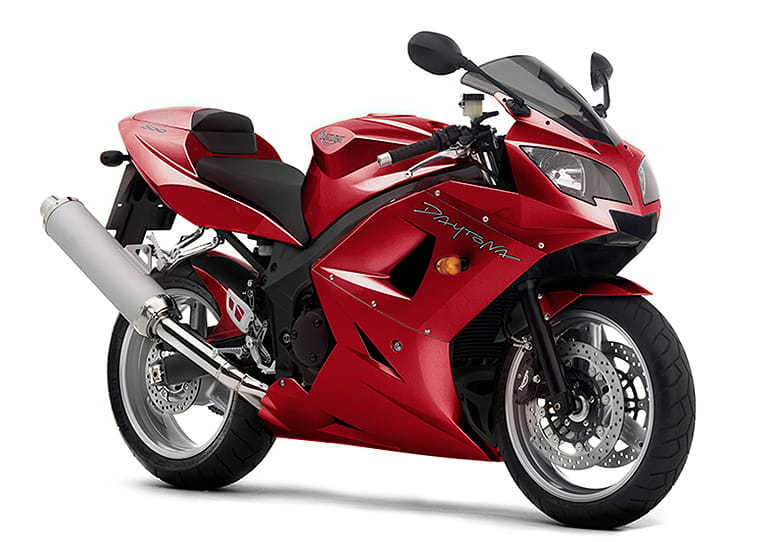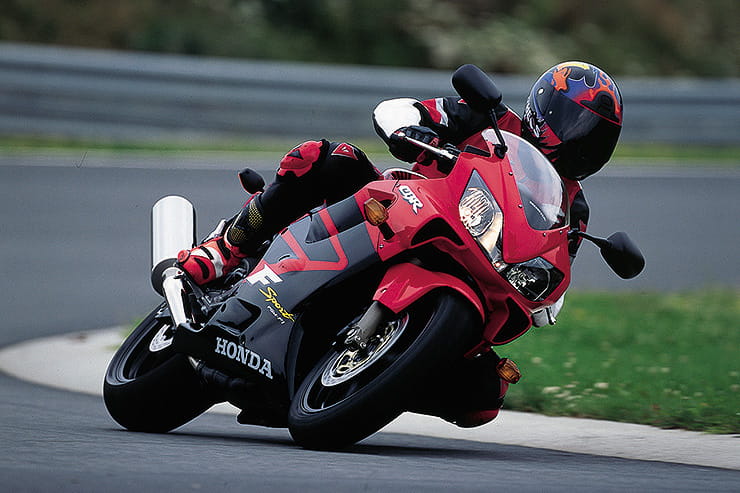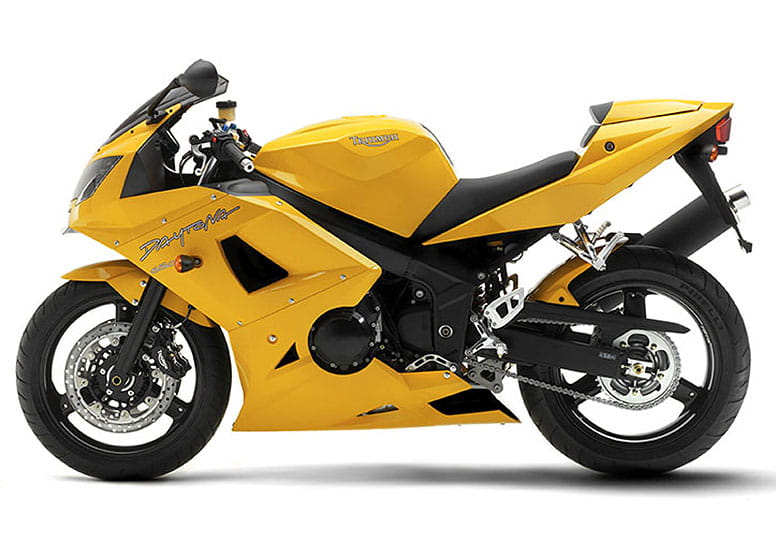
Price: £1500-£3500 | Power: 112bhp | Weight: 165kg | Overall BikeSocial Rating: 4/5
The Triumph Daytona 600 arrived in 2003 and did its best to banish memories of the somewhat disastrous TT600. Despite being very much a TT600 in a new set of clothes, the Daytona’s upgraded fuel-injection system, much better styling and tweaked chassis did enough to make it a genuine supersport contender – not to mention TT-winner. When you consider that put it up against the radical Honda CBR600RR and Kawasaki ZX-6R, not to mention the established Suzuki GSX-R600, Yamaha YZF-R6 and Honda CBR600F, that was an incredibly impressive feat for Triumph to achieve. Walking the line perfectly between sporty and practical, the Daytona was close enough to the full-on RR and ZX-6R in terms of handling to impress (even on track...) yet combined its agile chassis with a sensible, and roomy, riding position, making it appeal to more restrained CBR-F fans. In 2005 the stop-gap Daytona 650 arrived, adding a bit of mid-range, before it was discontinued in 2006 when the Daytona 675 triple landed. Although the sporty triple instantly stole all the headlines, the 600/650 inline four Daytona models remain much more compliant road bikes than the small and full-on 675. If you want a bike with a British name on its tank (which, cough, was actually built in the UK...) the Daytona 600 or 650 are great used options.
Triumph Daytona 600 and 650 (2003-2006) Price
The Daytona arrived at a time when supersport bikes were still fairly affordable and that means even used prices aren’t too horrible nowadays. You can pick up a tatty Daytona 600 for in the region of £1500 in a private sale but that does often either mean a bit of damage or a fairly high mileage, so really if you can up your budget to £2000-£2500 you are in a far better position. Armed with this amount you can get a tidy 600 or a 650 from either a dealer or private sale with the slight risk of going private offset by a bit of a price saving and generally a lower-mileage. Ideally, opt for the 650 as its extra mid-range is worth having and the gearbox’s action is noticeably improved, although don’t be too disheartened if you can only find a 600, it’s still a great buy.
Pros & Cons
- Strong engine, especially the 650
- Comfortable riding position
- Assured road handling
- There are a couple of question marks over build quality
- The gearbox is poor
- It does look a bit old-school
Engine and Performance
As the Daytona’s engine is basically the same as the TT600’s, in 2003 few expected much from it, however it provided a real surprise. With a claimed 10bhp or so less than the new breed of 600s, on paper the Daytona seemed well behind the game but that didn’t translate to how it performed – especially on the road. A sensation that still rings true nowadays.
Hop on a CBR600RR and you can’t help but feel a bit disappointed by its lack of mid-range as all of its power is located right at the top of the rev-range, forcing you to continually either work the gearbox or motor. Change to a Daytona (or the GSX-R600 or big-bore ZX-6R), however, and it has far more grunt that make it less effort to ride and much easier-going on the road as a result. With a claimed 112bhp (which is a genuine 100bhp at the rear) the Triumph is far from slow, and the fuel-injection is a million times better than the TT600’s system, but it is this smooth acceleration and strong mid-range drive that sets it aside. And if you buy the 650, which actually has a longer stroke motor rather than a bigger bore like the 636cc Kawasaki, it is even gutsier. But it’s not perfect and the Daytona does have a few mechanical issues that you need to be wary of when buying a used bike...
Starting with an easy one, the Daytona runs a clutch cut-out switch much like many Suzuki models. In the same way a sidestand cut-out can become sticky and fail, the same is true of the Triumph’s clutch cut-out (and to be fair also its sidestand cut-out switch!). If the bike won’t start, check this area first as it can not only become sticky but also wear in its mounting point, leading to its becoming erratic in its operation. It’s an easy item to swap but often a good squirt of light oil will sort it out if it is sticky, and the same is true of the sidestand cut-out, which is another common culprit with a non-starting bike.
Digging a bit deeper and the gearbox is an area of concern. On the 600 the gearbox is a bit poor with a clunky and not overly precise action, something Triumph addressed on the improved 650. The issue is mainly down to the gear linkages and fitting rearsets to the 600 improves it but as the 650 has not only a new linkage but also a redesigned seven-plate clutch (two less than the 600) and a backlash eliminating gear, it is a noticeably better system. When buying used, always ensure the gearbox has a smooth action with no false neutrals and also look for drips of oil around the shaft’s seal, which is a bit weak. Changing it is no huge drama aside from being a bit of a fiddle but always keep an eye on this area as any leaking oil is bad news.
Onto the fuel system and aside from the usual blocked filters (both air and the fuel filter, which is located within the tank), you need to ask when its throttle bodies were last balanced. The Daytona requires its throttle bodies balanced every 6000 miles and the secondary air injection system reset every 12,000-miles, which is often skipped and if left too long can make the bike run very roughly with a jerky throttle connection. Weirdly, if the bike has been left standing for a long period of time, the engine management light can also become stuck on. To turn it off the bike needs to be run through three complete heat cycles. Start the bike up and leave it ticking over until the fan kicks in. Repeat this twice more and the light should go out. If it doesn’t – be worried!
If all of the above is well, and the ECU’s fuel map updated should a race can be fitted, the Daytona’s motor is quite solid. Ensure the valve-clearances have been checked at 12,000-mile intervals (luckily it is quite roomy around the motor, so it’s not a massive job and cheaper than on a more compact modern supersport bike) and the oil and filters changed regularly and all should be well.
Although there was a 34bhp restrictor kit sold for the Daytona, it can’t be made A2-legal as Triumph claimed it made 112bhp when new, meaning it falls outside the performance criteria for restricting down to the current regulations.
Triumph Daytona 600 and 650 (2003-2006) Handling & Suspension
In 2003 the Daytona really shocked with its handling. Despite not being a full-on track-focused bike like the ZX-6R or CBR-RR, the Triumph still kept them very much in sight when ridden hard on a circuit. What was its secret? A lovely natural balance that allowed you to push on with confidence.
It’s no surprise the Daytona won at the TT as what makes it such a lovely road sportsbike is exactly what is required to take on the Isle of Man course. Unflappable over bumps, the Daytona’s suspension (it has conventional forks) and brakes may not be that flashy but they work and work very well indeed, delivering a lovely cushioned ride with more than enough braking performance on hand (and braided lines as standard). It’s one of those bikes that just seems perfectly at home on the road and as you aren’t forced into an uncomfortable racing stance, you can relax back and have lots of fun on the Triumph. And it can be made even better through an upgraded shock, fork rebuild, high-friction brake pads and set of sticky tyres, which isn’t much of an outlay for a big enhancement in handling and performance.
When buying used there isn’t anything that unusual to watch out for when it comes to the Daytona’s chassis. Having performed the usual checks such as chain and sprocket life, tyre thread depth, crash damage, suspension linkages (they need to be regressed regularly), rounded fasteners and broken fairing lugs, the remaining worry is finish. Sadly the Daytona is left a bit lacking in this department and corrosion and rust in hidden areas is a bit of a worry. Always check the bike thoroughly for corrosion as once it sets in, it can’t easily be fought off.
Comfort & Economy
Considering it is a supersport bike, the Daytona is remarkably comfortable. Noticeably bigger and roomier than the likes of the CBR-RR or Daytona 675, the 600 and 650 are more than up for long journeys. Maybe not lengthy tours but certainly day or a few days away trips. Fitting a taller screen helps reduce wind blast (the fairing is quite big) and there are even gel seat and various soft luggage options.
In terms of economy, you can expect mid-40mpg numbers which equates to roughly 180 miles to a tank, which is certainly acceptable. Hammer the engine and the economy plummets but that’s only to be expected.
Triumph Daytona 600 and 650 (2003-2006) Equipment
The Daytona is a very basic old-school supersport bike and as such you don’t even get a fuel gauge, let alone a gear indicator or any trick electronics. In many ways this is no bad thing as it does make it less prone to failure! And the good news is it comes with braided brake lines as standard, so that’s one area you don’t have to upgrade.
Triumph sold a range of accessories for the Daytona including an alarm/immobiliser, carbon or stainless steel silencer (non-road legal), taller screen, tank bag and even a few gel seat options. Generally, most used bikes will have an aftermarket exhaust fitted (check the bike has the ‘performance’ ECU upgrade, which was supplied to Triumph dealers), a taller screen and occasionally a tail tidy. That’s often where it ends with the Daytona and it is less common to find a bike festooned in goodies than a Japanese machine. If you want a gear indicator, it is possible to fit an aftermarket unit, which isn’t too tricky as many are plug-and-play items and will set you back around £100. Always be a bit wary of older alarm systems, they are often more trouble than they are worth and if the bike is sold by a dealer, ask to get it removed.
The Daytona will appeal to anyone who wants a relatively cheap supersport bike that isn’t too full-on in terms of its track focus and is easy to insure, making it a good option for newer riders or those quite young. That puts it up against the older breed of supersport machines such as the F-Sport, early GSX-R or older 636 Ninja.
Honda CBR600F Sport (2001-2002) | Approx Price: £2000-£4000
Power/Torque: 109bhp/48lb-ft | Weight: 167kg
Suzuki GSX-R600 (2001-2003) | Approx Price: £1500-£3500
Power/Torque: 101bhp/48lb-ft | Weight: 163kg
Kawasaki ZX-6R (2002) | Approx Price: £1800-£3500
Power/Torque: 113bhp/50.7lb-ft | Weight: 174kg

Triumph Daytona 600 and 650 (2003-2006) Verdict
The Triumph Daytona 600, and especially the 650, make for great road-going supersport bikes. As well as being pleasingly roomy to ride, Triumph have done a perfect job on the Daytona’s chassis and that makes it huge amounts of fun to attack corners on without getting too serious and sports-focused and forgetting the important parts such as compliant suspension. Relatively cheap in the used market, although undeniably not as well built or flashy as its Japanese rivals, the British bike is much more accommodating and that ultimately makes it a better buy for those who have no real interest in track riding. Forget about the TT600 debacle, buy the Daytona 600 or 650 and be prepared to be surprised – in a good way! It’s not perfect but it is a lovely road-going supersport bike.
If you’d like to chat about this article or anything else biking related, join us and thousands of other riders at the Bennetts BikeSocial Facebook page.
Triumph Daytona 600 and 650 (2003-2006) – Technical Specification
|
Original price
|
£6289 (£6439)
|
|
Current price range
|
£1500 - £3500
|
|
Capacity
|
599cc (646cc)
|
|
Bore x Stroke
|
68mm x 41.3mm (68mm x 44.5mm)
|
|
Engine layout
|
Inline four
|
|
Engine details
|
16v, DOHC, liquid-cooled
|
|
Power
|
112bhp (81.6kW)@ 12,750rpm (114bhp (83.4kW)@ 12,500rpm)
|
|
Torque
|
50.5lb-ft (68Nm) @ 11,000rpm (50.5lb-ft (68Nm) @ 11,500rpm)
|
|
Top speed
|
160mph
|
|
Transmission
|
Six-speed, chain final drive
|
|
Average fuel consumption
|
46mpg
|
|
Tank size
|
18 litres
|
|
Max range to empty (theoretical)
|
184 miles
|
|
Reserve capacity
|
29 miles
|
|
Rider aids
|
None
|
|
Frame
|
Aluminium beam
|
|
Front suspension
|
43mm conventional fork
|
|
Front suspension adjustment
|
Fully-adjustable
|
|
Rear suspension
|
Monoshock
|
|
Rear suspension adjustment
|
Fully-adjustable
|
|
Front brake
|
2 x 308mm discs, four-piston calipers.
|
|
Rear brake
|
220mm disc, single-piston caliper.
|
|
Front tyre
|
120/70-ZR17
|
|
Rear tyre
|
180/55- ZR17
|
|
Rake/Trail
|
24.6°/ 89.1mm
|
|
Dimensions (LxWxH)
|
2050mm x 660mm x 1135mm
|
|
Wheelbase
|
mm
|
|
Ground clearance
|
n/a
|
|
Seat height
|
815mm
|
|
Kerb weight
|
165Kg Dry
|
Looking for motorcycle insurance? Get a quote for this motorbike with Bennetts bike insurance
Used bike images courtesy of PW Performance





















